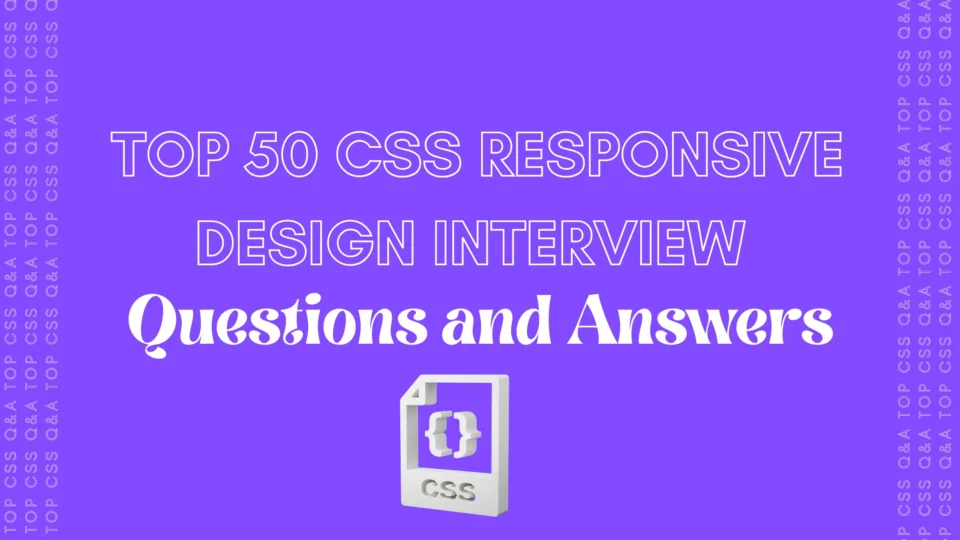Responsive web design is crucial in today’s multi-device world. Whether you’re a beginner or preparing for an advanced front-end role, mastering responsive CSS concepts is essential. Below is a comprehensive list of the 50 most asked responsive CSS interview questions with clear and concise answers.
Basic Level Questions (1–15)
1. What is responsive web design?
Responsive web design is a design approach that ensures a website looks good and functions well across all device sizes, from desktops to smartphones.
2. How does responsive design differ from adaptive design?
Responsive design uses fluid grids and CSS media queries. Adaptive design uses fixed layouts based on breakpoints.
3. What are media queries in CSS?
Media queries allow CSS to be applied conditionally based on the device’s characteristics such as width, height, or orientation.
4. Can you write a basic media query example?
@media (max-width: 768px) {
body {
background-color: lightblue;
}
}
5. What does @media (max-width: 768px) mean?
It targets screens with a maximum width of 768 pixels, typically tablets or smaller devices.
6. Why is the viewport meta tag important?
It controls layout on mobile browsers. Without it, responsive layouts break. Example:
<meta name="viewport" content="width=device-width, initial-scale=1">
7. How can you make images responsive?
Use:
img {
max-width: 100%;
height: auto;
}
8. What are vh, vw, em, and rem units?
vh: viewport heightvw: viewport widthem: relative to parent font-sizerem: relative to root font-size
9. Difference between px, em, and rem?
px: fixed unitem: scalable, based on parentrem: scalable, based on root
10. How to create a mobile-first design?
Start with base styles for mobile, then use min-width media queries for larger screens.
11. Difference between mobile-first and desktop-first design?
Mobile-first starts with smaller screens and scales up. Desktop-first starts with large and scales down.
12. How to hide elements on small screens?
@media (max-width: 600px) {
.hide-on-mobile {
display: none;
}
}
13. What does flex-wrap: wrap do?
It allows flex items to wrap onto multiple lines instead of staying in one row.
14. Difference between auto-fill and auto-fit in CSS Grid?
auto-fill: fills available space, even if cells are emptyauto-fit: collapses empty tracks
15. How can you use percentage values for layouts?
Percentage values make widths and heights relative to parent, enabling fluid layouts.
Intermediate Level Questions (16–35)
16. How does Flexbox help with responsive design?
Flexbox provides alignment, distribution, and spacing tools that adapt to screen size.
17. How can CSS Grid help create responsive layouts?
It allows defining layout structures that automatically adjust with media queries or auto-fit/auto-fill.
18. What is a fluid layout?
Layouts that use percentage-based widths and scale fluidly across devices.
19. What is the clamp() function?
It sets responsive values within a range. Example: font-size: clamp(1rem, 2vw, 2rem);
20. What are breakpoints?
They define where layout changes should occur to support different devices.
21. Common breakpoints used:
- Mobile: 320px – 480px
- Tablet: 768px
- Desktop: 1024px
- Large Screens: 1200px+
22. Common challenges in responsive design?
- Cross-browser support
- Image optimization
- Font scaling
23. How to make multi-column layouts responsive?
Use Flexbox or Grid with media queries to adjust column count.
24. min-width vs max-width in media queries?
min-width: applies from the defined width and up (mobile-first)max-width: applies up to the defined width (desktop-first)
25. Targeting high-DPI screens:
@media only screen and (-webkit-min-device-pixel-ratio: 2) {
/* High DPI styles */
}
26. display: block vs inline-block?
block: takes full widthinline-block: sits inline but can have width/height
27. Why avoid fixed width in responsive design?
Fixed widths don’t adapt; use relative units instead.
28. object-fit and object-position use?
Used to scale and position images/videos within containers.
29. Role of aspect-ratio:
Maintains element proportions. Example: aspect-ratio: 16 / 9;
30. What are container queries?
They apply styles based on the size of the parent container, not the viewport.
31. Centering a div using Flexbox:
display: flex;
justify-content: center;
align-items: center;
32. Create responsive navigation menu:
Use media queries to switch from horizontal to hamburger menu on small screens.
33. Best practices for responsive typography:
Use em, rem, and clamp() for scalable font sizes.
34. Responsive vs scalable design:
Responsive adapts to device size; scalable adapts to zoom levels and accessibility.
35. How to test responsive layouts?
Use browser DevTools, emulators, and real devices.
Advanced Level Questions (36–50)
36. How to optimize performance for responsive sites?
- Compress images
- Lazy load content
- Minimize CSS/JS
37. Implementing responsive tables:
Use overflow-x: auto or stack table rows using media queries.
38. How to make forms responsive?
Use flexible widths, media queries, and stack inputs vertically on smaller screens.
39. Responsive utility classes (e.g., Bootstrap):
Pre-defined classes like .d-none d-md-block help show/hide elements.
40. Tailwind CSS and responsive design:
Utility-first approach with classes like sm:text-sm md:text-lg.
41. Container width in frameworks:
Controls max-width for different devices to ensure content readability.
42. Mobile-first vs component-first CSS:
Mobile-first scales layout from small to large; component-first styles individual components.
43. Combining min(), max() and clamp():
font-size: clamp(1rem, 2vw, 2rem);
44. Creating responsive layout without media queries:
Use flex-wrap, grid auto, and clamp() for adaptability.
45. How picture tag helps:
Serves different image sizes based on device:
<picture>
<source media="(max-width: 600px)" srcset="small.jpg">
<img src="default.jpg" alt="">
</picture>
46. visibility: hidden vs display: none vs opacity: 0:
visibility: hidden: hidden but occupies spacedisplay: none: hidden and removed from flowopacity: 0: visible space, but invisible element
47. Implement responsive image gallery:
Use CSS Grid or Flexbox with fluid image sizes and breakpoints.
48. Making iframes responsive:
Wrap iframe in a div and use padding hack:
.responsive-iframe {
position: relative;
padding-bottom: 56.25%;
height: 0;
overflow: hidden;
}
.responsive-iframe iframe {
position: absolute;
width: 100%;
height: 100%;
}
49. Benefits of CSS variables in responsive design:
You can change themes and spacing dynamically using --var() and media queries.
50. Dark mode media query:
@media (prefers-color-scheme: dark) {
body {
background-color: #000;
color: #fff;
}
}

